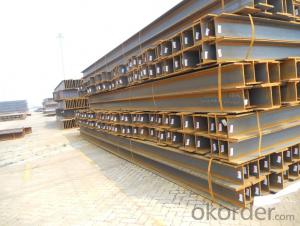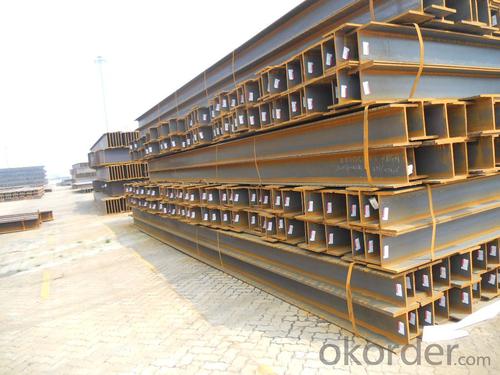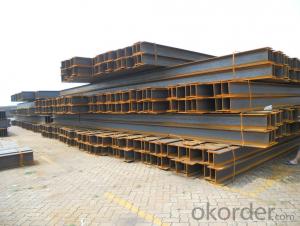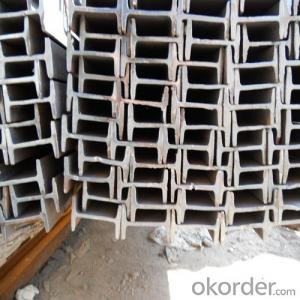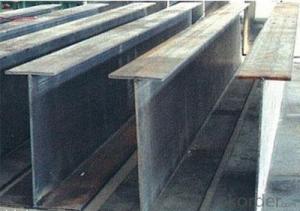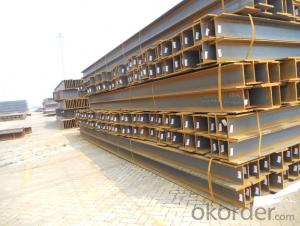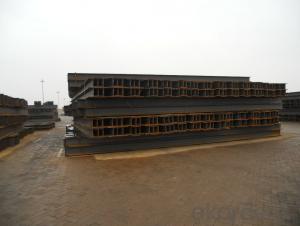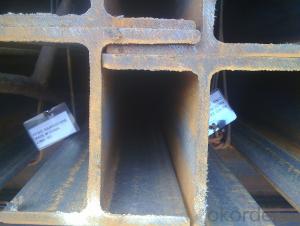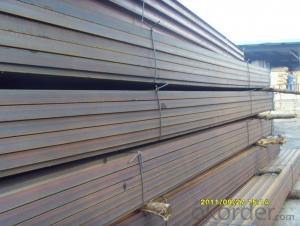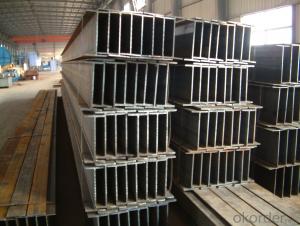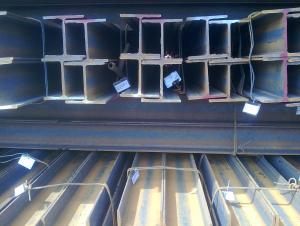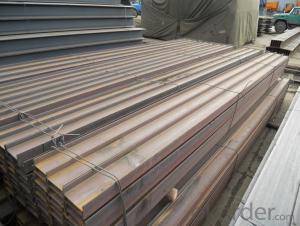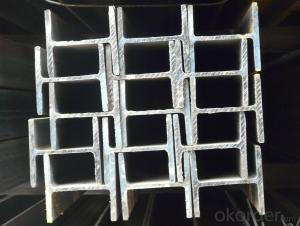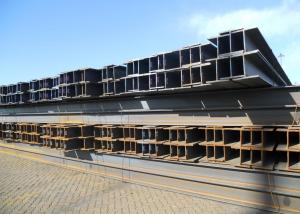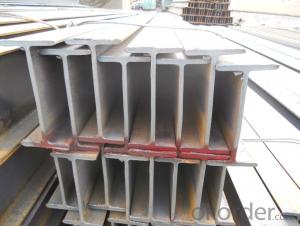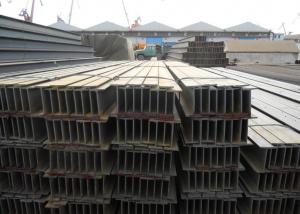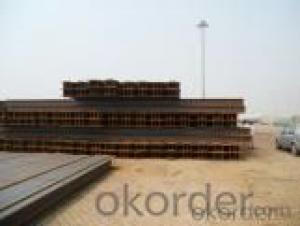Hot Rolled Steel H-BEAM JIS SS400 GB Q235 OR Equivalent
- Loading Port:
- Tianjin
- Payment Terms:
- TT OR LC
- Min Order Qty:
- 500 m.t.
- Supply Capability:
- 5000 m.t./month
OKorder Service Pledge
OKorder Financial Service
You Might Also Like
Specification
Product Description:
OKorder is offering Hot Rolled Steel H-BEAM JIS SS400 GB Q235 OR Equivalent at great prices with worldwide shipping. Our supplier is a world-class manufacturer of steel, with our products utilized the world over. OKorder annually supplies products to European, North American and Asian markets. We provide quotations within 24 hours of receiving an inquiry and guarantee competitive prices.
Product Applications:
Hot Rolled Steel H-BEAM JIS SS400 GB Q235 OR Equivalent are ideal for structural applications and are widely used in the construction of buildings and bridges, and the manufacturing, petrochemical, and transportation industries.
Product Advantages:
OKorder's Hot Rolled Steel H-BEAM JIS SS400 GB Q235 OR Equivalent are durable, strong, and resist corrosion.
Main Product Features:
· Premium quality
· Prompt delivery & seaworthy packing (30 days after receiving deposit)
· Corrosion resistance
· Can be recycled and reused
· Mill test certification
· Professional Service
· Competitive pricing
Product Specifications:
1. Standard: JIS 3192
2. Grade: SS400 or Equivalent
3. Length: 10m, 12m as following table
4. Invoicing on theoretical weight or actual weight as customer request
5.Payment: TT or L/C
Size and Mass of H beam:
Size (mm) | Mass (Kg/m) | Size (mm) | Mass (Kg) |
298*149*5.5 | 32.0 | 294*200*8.0 | 55.8 |
300*150*6.5 | 36.7 | 294*302*12.0 | 83.4 |
Usage of Prime Hot Rolled H Beam Steel :
(1). for the plant, high-rise building construction
(2). for the bridge, shipment building
(3).for lifting and transportation machinery, equipment manufacturing base building
(4). for the support, foundation pile manufacturing
Packaging & Delivery of Hot Rolled Structural Steel H Beam
1. Packing: it is nude packed in bundles by steel wire rod
2. Bundle weight: not more than 3.5MT for bulk vessel; less than 3 MT for container load
3. Marks:
Color marking: There will be color marking on both end of the bundle for the cargo delivered by bulk vessel. That makes it easily to distinguish at the destination port.
Tag mark: there will be tag mark tied up on the bundles. The information usually including supplier logo and name, product name, made in China, shipping marks and other information request by the customer.
If loading by container the marking is not needed, but we will prepare it as customer request.
4. Transportation: the goods are delivered by truck from mill to loading port, the maximum quantity can be loaded is around 40MTs by each truck. If the order quantity cannot reach the full truck loaded, the transportation cost per ton will be little higher than full load.
5. Delivered by container or bulk vessel
FAQ:
Q1: Why buy Materials & Equipment from OKorder.com?
A1: All products offered byOKorder.com are carefully selected from China's most reliable manufacturing enterprises. Through its ISO certifications, OKorder.com adheres to the highest standards and a commitment to supply chain safety and customer satisfaction.
Q2: How do we guarantee the quality of our products?
A2: We have established an advanced quality management system which conducts strict quality tests at every step, from raw materials to the final product. At the same time, we provide extensive follow-up service assurances as required.
Q3: How soon can we receive the product after purchase?
A3: Within three days of placing an order, we will begin production. The specific shipping date is dependent upon international and government factors, but is typically 7 to 10 workdays.
Q4: What makes stainless steel stainless?
A4: Stainless steel must contain at least 10.5 % chromium. It is this element that reacts with the oxygen in the air to form a complex chrome-oxide surface layer that is invisible but strong enough to prevent further oxygen from "staining" (rusting) the surface. Higher levels of chromium and the addition of other alloying elements such as nickel and molybdenum enhance this surface layer and improve the corrosion resistance of the stainless material.
Q5: Can stainless steel rust?
A5: Stainless does not "rust" as you think of regular steel rusting with a red oxide on the surface that flakes off. If you see red rust it is probably due to some iron particles that have contaminated the surface of the stainless steel and it is these iron particles that are rusting. Look at the source of the rusting and see if you can remove it from the surface.
Images:
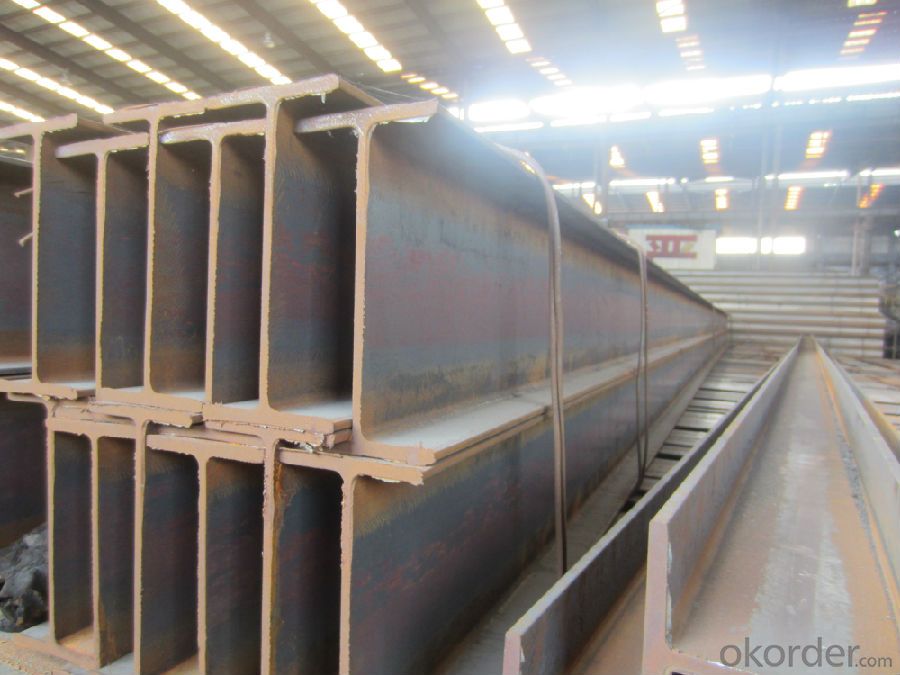
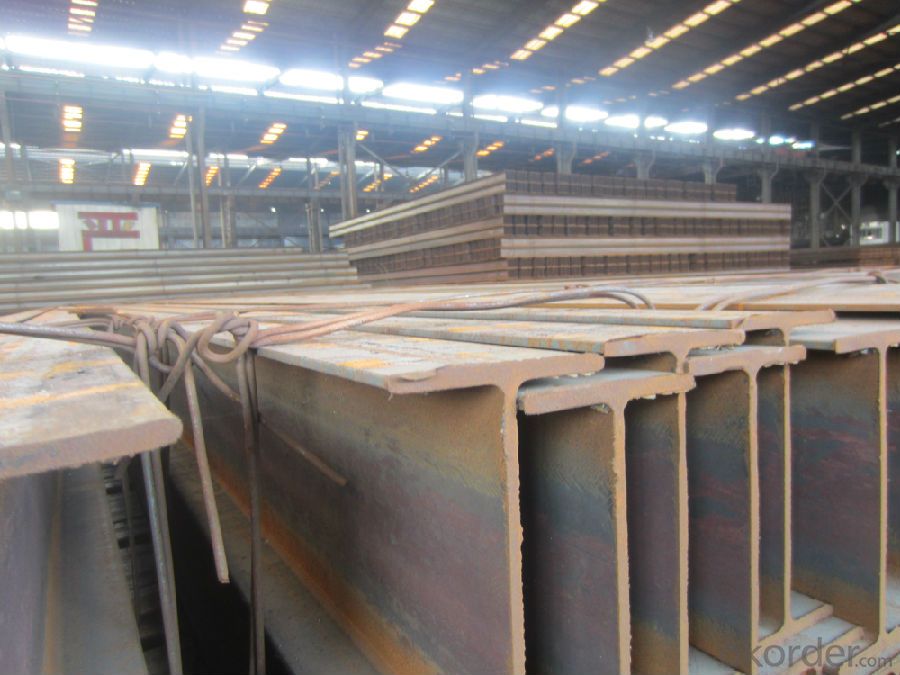
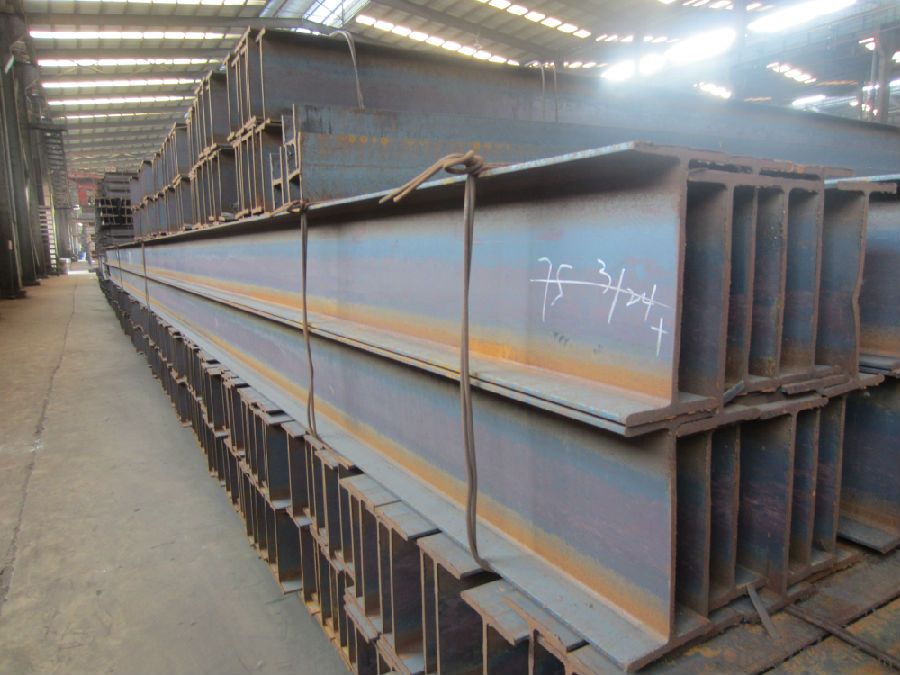
- Q: Can steel H-beams be used for exhibition halls or convention centers?
- Yes, steel H-beams can be used for exhibition halls or convention centers. Steel H-beams are commonly used in construction due to their high strength and durability. They provide structural support and can withstand heavy loads, making them suitable for large and open spaces like exhibition halls or convention centers. Additionally, steel H-beams can be easily fabricated and customized to meet specific design requirements and can be used to create large-span structures without the need for excessive columns or supports. Overall, steel H-beams are a popular choice for building exhibition halls or convention centers as they offer strength, flexibility, and cost-effectiveness.
- Q: Can steel H-beams be used for vehicle ramps or bridges?
- Indeed, vehicle ramps or bridges can utilize steel H-beams. Due to their robustness and endurance, steel H-beams are frequently employed in construction endeavors. Their ability to bear substantial weights and offer stability renders them suitable for such purposes. Moreover, steel H-beams possess the benefit of cost-effectiveness and ready availability, thus making them a favored option for such applications. Nevertheless, it is crucial to take into account the precise requirements and design considerations of the ramp or bridge project to guarantee that the steel H-beams are adequately sized and installed in accordance with the required safety standards.
- Q: Can steel H-beams be used in healthcare or hospital construction?
- Yes, steel H-beams can be used in healthcare or hospital construction. They are commonly used in structural applications due to their strength and durability. Steel H-beams provide the necessary support and stability required for constructing large and complex healthcare facilities.
- Q: What are the different grades of steel used for H-beams?
- The specific requirements and applications determine the varying grades of steel used for H-beams. Some commonly used grades include ASTM A36, ASTM A572, and ASTM A992. 1. ASTM A36 is the most frequently utilized grade for H-beams. It possesses a minimum yield strength of 36,000 psi and is popular in construction and structural applications due to its exceptional weldability and cost-effectiveness. This steel grade is suitable for medium to heavy-duty applications where strength and durability are necessary. 2. H-beams in high-strength applications often utilize ASTM A572. This grade has a minimum yield strength of 50,000 psi and offers higher strength and improved notch toughness compared to ASTM A36. ASTM A572 steel is frequently employed in construction, bridges, and other structural applications that require superior strength. 3. In heavy-duty applications, ASTM A992 is a commonly used high-strength, low-alloy structural steel grade for H-beams. It has a minimum yield strength of 50,000 psi and provides excellent weldability and formability. ASTM A992 steel is prevalent in high-rise buildings, bridges, and other critical structural applications that demand superior strength and stability. These examples highlight the diverse grades of steel used for H-beams. The choice of grade depends on factors such as required strength, load-bearing capacity, and the specific application of the H-beam. It is crucial to consult relevant industry standards and specifications to determine the appropriate steel grade for a particular project.
- Q: How do steel H-beams perform in areas with high rainfall or moisture?
- Steel H-beams are highly resistant to moisture and are commonly used in areas with high rainfall or moisture. The structural integrity of steel H-beams remains unaffected by water, as steel is inherently resistant to corrosion and decay. Additionally, steel H-beams are often coated with protective finishes such as galvanization or paint, further enhancing their resistance to moisture. This makes them ideal for construction projects in areas prone to heavy rainfall, coastal regions, or high humidity environments. The robustness and durability of steel H-beams ensure their long-term performance and structural stability, even in the presence of moisture.
- Q: What are the different sizes of steel H-beams available?
- Steel H-beams, also known as wide flange beams, come in a variety of sizes to suit different construction and engineering needs. The sizes of steel H-beams are typically determined by their dimensions, including height, width, and weight per foot. Here are some common sizes of steel H-beams: 1. Standard H-beams: These are the most commonly used H-beams and have dimensions that are defined by the American Society for Testing and Materials (ASTM). Standard H-beams come in various sizes, ranging from 3 inches to 24 inches in height and from 3 inches to 12 inches in width. The weight per foot of standard H-beams can vary depending on the specific size and grade of steel used. 2. Wide flange beams: Also referred to as W-beams, wide flange beams have wider flanges compared to standard H-beams. The flanges are designed to distribute the load over a larger area, making them suitable for applications requiring higher load-bearing capacity. Wide flange beams are available in sizes ranging from 4 inches to 44 inches in height and from 4 inches to 16 inches in width. 3. European standard beams: In addition to the American standard sizes, there are also European standard beams, which are designated by their height in millimeters. These beams are commonly used in Europe and have dimensions that range from 80 mm to 750 mm in height. 4. Specialized H-beams: Apart from the standard and European sizes, there are also specialized H-beams available for specific applications. These include heavy-duty H-beams used in industrial and structural applications, as well as lightweight H-beams used in residential construction and smaller-scale projects. It is important to note that the availability of different sizes may vary depending on the supplier or manufacturer. When selecting steel H-beams for a project, it is recommended to consult with a structural engineer or supplier who can provide guidance on the appropriate size and grade of H-beams for the specific application.
- Q: Are Steel H-Beams suitable for theater or performing arts center construction?
- Indeed, when it comes to theater or performing arts center construction, Steel H-Beams are a suitable choice. In the construction industry, these H-Beams are widely utilized due to their commendable robustness and endurance. They provide exceptional support and ensure the structural integrity, thus making them highly suitable for extensive projects such as theaters or performing arts centers. The unique shape of the H-Beam allows for an even distribution of weight, thereby reducing the possibility of any structural failures. Furthermore, steel possesses fire-resistant properties, an essential feature for buildings that accommodate large crowds. In addition, the fabrication and installation of steel H-Beams are relatively effortless, which enhances the efficiency of the construction process. Ultimately, the strength and stability offered by steel H-Beams fulfill the requirements for theater or performing arts center construction.
- Q: How do steel H-beams contribute to waste reduction in construction?
- Steel H-beams play a significant role in waste reduction in construction for several reasons. Firstly, steel H-beams are incredibly durable and long-lasting, ensuring that the structures they support have a longer lifespan. This longevity reduces the need for frequent repairs or replacements, thus minimizing waste generated from these activities. Moreover, steel H-beams can be easily recycled at the end of their life cycle. When a building is demolished or renovated, the steel beams can be collected and sent to recycling facilities. Unlike other construction materials, steel can be recycled indefinitely without losing its quality. By recycling steel H-beams, we reduce the amount of waste that would otherwise end up in landfills. Additionally, steel H-beams are lightweight compared to other construction materials, such as concrete or wood. Their lightweight nature simplifies transportation and installation, requiring fewer resources and energy. This reduces the environmental impact associated with transportation emissions and lowers the overall waste generation during the construction process. Furthermore, steel H-beams offer a flexible and adaptable design solution. They can be easily modified, reconfigured, or reused in different projects. This adaptability minimizes the need for new materials and reduces construction waste. It also allows for more sustainable practices, such as deconstructing and repurposing existing structures instead of demolishing them entirely. In summary, steel H-beams contribute to waste reduction in construction through their durability, recyclability, lightweight nature, and adaptability. By using these beams, we can extend the lifespan of structures, recycle materials at the end of their life cycle, reduce transportation emissions, and promote a more sustainable construction industry.
- Q: How long do steel H-beams typically last?
- Steel H-beams typically have a very long lifespan and can last for several decades or even longer, depending on various factors such as the quality of the steel, environmental conditions, and maintenance.
- Q: What are the typical uses of steel H-beams in construction projects?
- Steel H-beams are commonly used in construction projects for a variety of purposes. One of the typical uses of steel H-beams is for structural support in buildings and bridges. These beams are designed to withstand heavy loads and provide stability to the structure. In building construction, steel H-beams are used as columns and beams to support the weight of the building and distribute the load evenly. They are commonly used in high-rise buildings, industrial structures, and warehouses. H-beams are also used in the construction of bridges, where they provide the necessary strength and stability to support the weight of the bridge and the traffic passing over it. Another typical use of steel H-beams is in the construction of mezzanine floors. Mezzanine floors are intermediate floors that are built within a building to create additional usable space. H-beams are used as the primary support structure for these floors, providing the necessary strength and stability. Steel H-beams are also commonly used in the construction of platforms, walkways, and staircases. They provide a sturdy and reliable structure for these elements, ensuring the safety of those using them. Overall, steel H-beams are essential components in construction projects, providing structural support, stability, and strength. Their versatility and durability make them a popular choice in various construction applications.
Send your message to us
Hot Rolled Steel H-BEAM JIS SS400 GB Q235 OR Equivalent
- Loading Port:
- Tianjin
- Payment Terms:
- TT OR LC
- Min Order Qty:
- 500 m.t.
- Supply Capability:
- 5000 m.t./month
OKorder Service Pledge
OKorder Financial Service
Similar products
Hot products
Hot Searches
Related keywords
